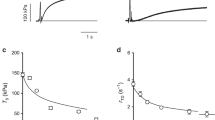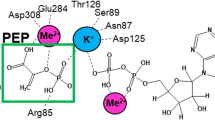Abstract
WE have reported that the puzzling inhibition of (Na+ + K+)ATPase preparations by K+ ions, at concentrations insufficient to displace Na+ ions from the intracellular Na+-loading sites, was observed only when Sigma ‘Sigma-grade’ ATP was used as a substrate1. The effect was attributed to a contaminant of the ATP, which bound to the enzyme reversibly but with a high affinity; and because ‘Sigma-grade’ ATP is unique in being prepared from muscle, we suggested that the inhibitor might have a physiological role. Similar conclusions were reached independently by Cantley and Josephson2,3, and they and their colleagues have now identified the contaminant as ortho-vanadate4. The inhibition of (Na+ + K+)ATPase by vanadate plus K+ ions is of interest both for its possible physiological significance—traces of vanadate occur widely in animal tissues5—and for its possible use in elucidating the mechanism of the sodium pump. From both points of view it is desirable to know whether the K+ ions act at the intracellular or extracellular surface of the membrane, and we report here experiments on resealed red cell ghosts showing that the action of K+ ions is at the extracellular surface. In the following paper, Cantley et al.6 describe experiments with intact red cells suggesting that the vanadate ions act at the intracellular surface.
This is a preview of subscription content, access via your institution
Access options
Subscribe to this journal
Receive 51 print issues and online access
$199.00 per year
only $3.90 per issue
Buy this article
- Purchase on Springer Link
- Instant access to full article PDF
Prices may be subject to local taxes which are calculated during checkout
Similar content being viewed by others
References
Beaugé, L. A. & Glynn, I. M. Nature 268, 355–356 (1977).
Fagan, J. B. & Racker, E. Biochemistry 16, 158 (1977).
Josephson, L. & Cantley, L. C. Biochemistry 16, 4572–4578 (1977).
Cantley, L. C. et al. J. biol. Chem. 252, (in the press).
Hopkins, L. L. in Trace Element Metabolism in Animals Vol. 2. (eds Hoekstra, W. G., Suttie, J. W., Ganther, H. E. & Mertz, W.) 397–406 (University Park Press, Baltimore, 1974).
Cantley, L. C., Resh, M. & Guidotti, G. Nature (following paper).
Glynn, I. M. J. Physiol., Lond. 134, 278–310 (1956).
Lopez, V., Stevens, T. & Lindquist, R. N. Archs Biochem. Biophys. 175, 31–38 (1976).
Jørgensen, P. L. Biochem. biophys. Acta 401, 399–415 (1975).
Jørgensen, P. L. Biochim. biophys. Acta 466, 97–108 (1977).
Wright, F. S., Streider, N., Fowler, N. B. & Giebisch, G. Am. J. Physiol. 221, 437–448 (1971).
Jørgensen, P. L. Biochim. biophys. Acta 356, 36–52 (1974).
Author information
Authors and Affiliations
Rights and permissions
About this article
Cite this article
BEAUGÉ, L., GLYNN, I. Commercial ATP containing traces of vanadate alters the response of (Na+ + K+)ATPase to external potassium. Nature 272, 551–552 (1978). https://doi.org/10.1038/272551a0
Received:
Accepted:
Issue Date:
DOI: https://doi.org/10.1038/272551a0
This article is cited by
-
Peripheral erythrocyte levels, hemolysis and three vanadium compounds
Experientia (1990)
-
Effect of chronic vanadate ingestion on amino acid and water absorption in rat intestine
Archives of Toxicology (1989)
-
Subchronic treatment with vanadate does not potentiate the toxicity of cardiac glycosides
Biological Trace Element Research (1988)
-
Vanadate stimulates the pumped movements of Na in skeletal muscle
Pfl�gers Archiv European Journal of Physiology (1984)
-
Vanadate and ouabain: a comparative study in toad skin
Pfl�gers Archiv European Journal of Physiology (1984)
Comments
By submitting a comment you agree to abide by our Terms and Community Guidelines. If you find something abusive or that does not comply with our terms or guidelines please flag it as inappropriate.



